- What are Bank BeEs?
- What is the composition of Bank BeEs?
- 10 Advantages of Bank BeEs.
- Bank BeEs Vs Banking Sector Mutual Funds
What are Bank BeEs?
BeEs stands for Benchmark Exchange Traded Scheme. Bank BeEs is an exchange traded fund which invests in only banking stocks. It was launched by Nippon India Mutual Fund (formerly Reliance Nippon Mutual Fund) on 27th May 2004. The full form of Bank BeEs is Nippon India ETF Bank BeEs. It is benchmarked to the Nifty Bank Index which contains 12 of the biggest most liquid banking stocks listed on the National Stock Exchange (NSE). The aim of Bank BeEs is to mirror the returns of the country’s top ten banks at 1/100th the cost. For example: The price of 1 unit of Bank Nifty is Rs 34,800 as on 9th June 2021. On the same day, the NAV of Bank BeEs is Rs 351.40 (roughly 1/100th of Rs 34,800). 95% of Bank BeEs corpus is invested as per Nifty Bank Index. The remaining 5% is invested in money market instruments like Treasury Bills, Certificates of Deposits. Bank BeEs are highly popular in India compared to other BeEs. The Assets under Management (AUM) of Bank BeEs is Rs 8,257 crores.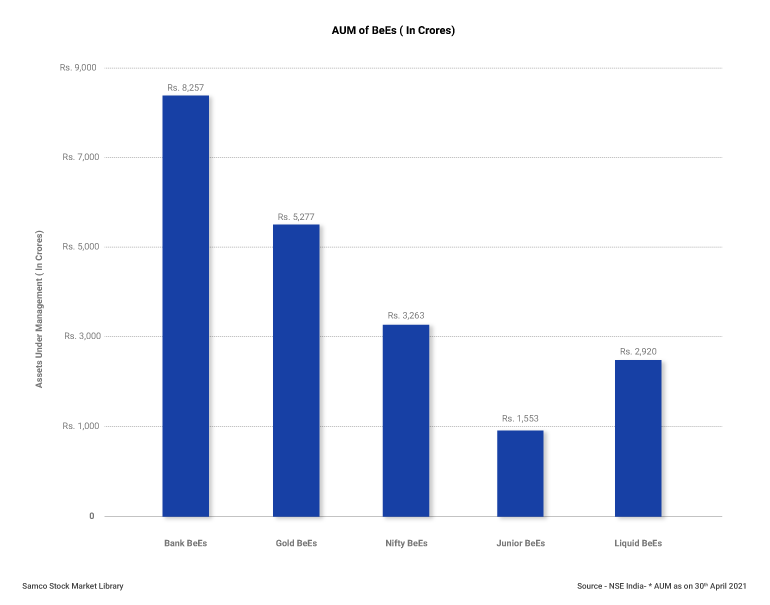
What is the Composition of Bank BeEs?
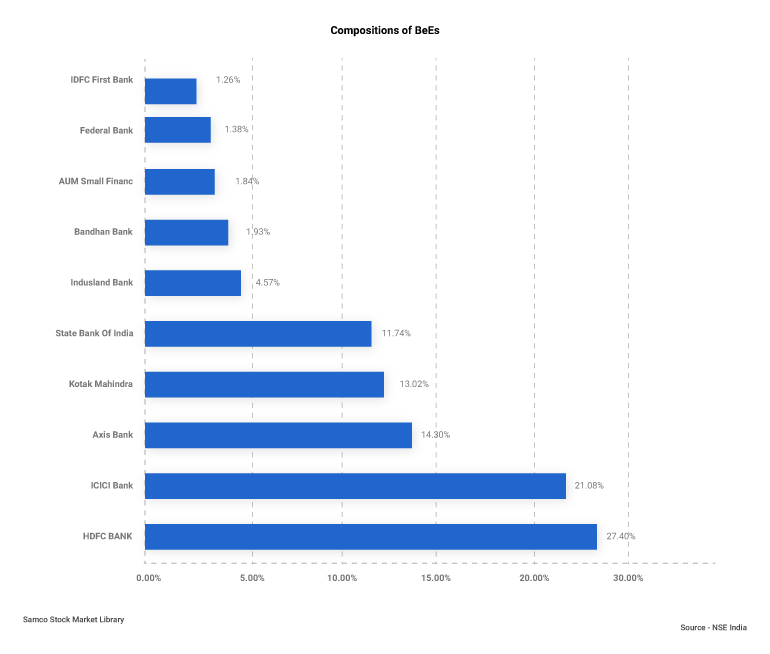
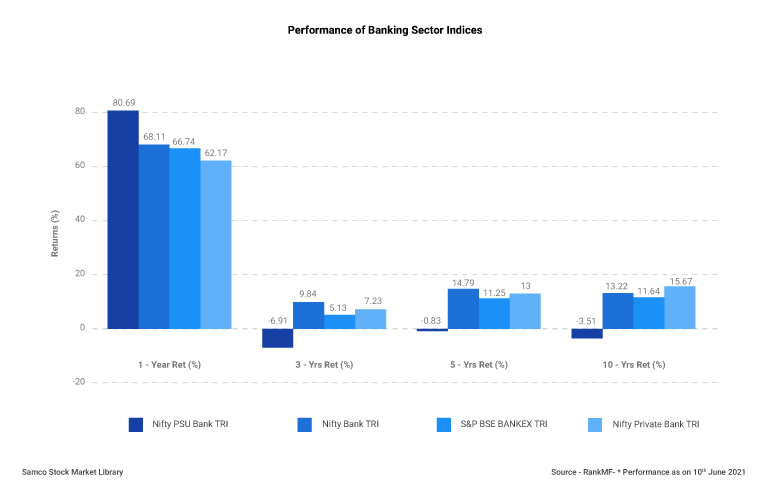
10 Advantages of Bank BeEs
- Pocket Friendly: To purchase one stock each of the ten banks in Bank BeEs, you will need Rs 7,519 (as on 9th June 2021). But with Bank BeEs, you can invest in the same ten stocks with just Rs 351.40.
- Less Risky Compared to Sectoral Mutual Funds: Even the mutual fund universe has banking themed sectoral funds. For example: SBI Banking & Financial Services Fund invests in nearly 28 different banks. While these funds are high on diversification, they do have a small flaw. They invest a sizable portion in stocks like ICICI Prudential Life Insurance Company Ltd, CSB Bank Ltd.etc. Such low rated stocks make sectoral funds riskier than Bank BeEs.
- Low Expense Ratio: Bank BeEs are passively managed ETFs. The aim of the fund manager is not to outperform the benchmark. His aim is to simply mirror the returns of the Nifty Bank index. The fund manager creates an exact replica of the index. This eliminates the research and management costs of ETFs. This is why Bank BeEs have an exceptionally lower expense ratio compared to actively managed funds.
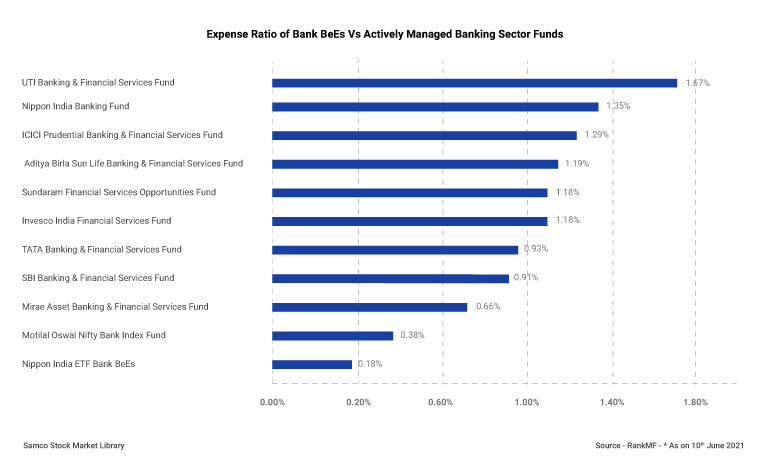
- Superior Returns: Lower expense ratio directly increases your fund’s returns. Since Bank BeEs has the lowest expense ratio, it has generated superior returns than actively managed mutual funds.
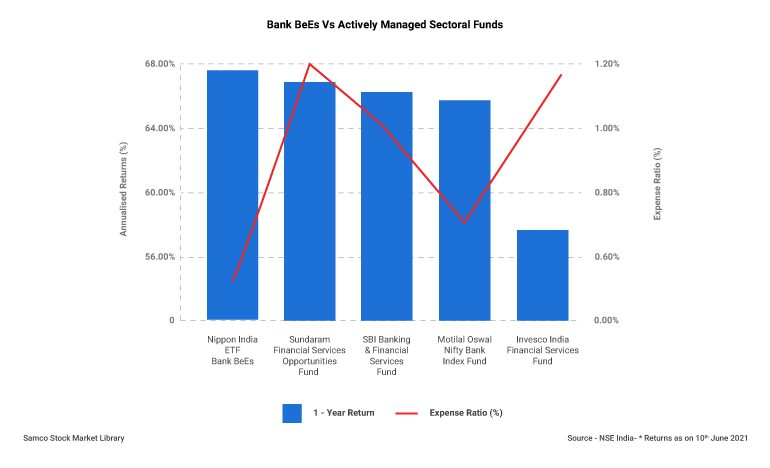
- ICICI Prudential Banking & Financial Services Fund has generated a one-year return of 77.51%. Its expense ratio is 1.29%.
- Nippon India Banking Fund’s one-year return is 86% and its expense ratio is 1.35%.
- High Liquidity: Bank BeEs are highly liquid. They are twice as liquid as Nifty BeEs. This liquidity encourages participation of institutional investors. A highly liquid environment nurtures futures and options (F&O) trading in Nifty Bank index. This also provides an opportunity for retail investors to make money in Bank Nifty without worrying about their exits. As you can see, there has been a 585% absolute increase in the turnover of Bank BeEs between 2017 and 2020.
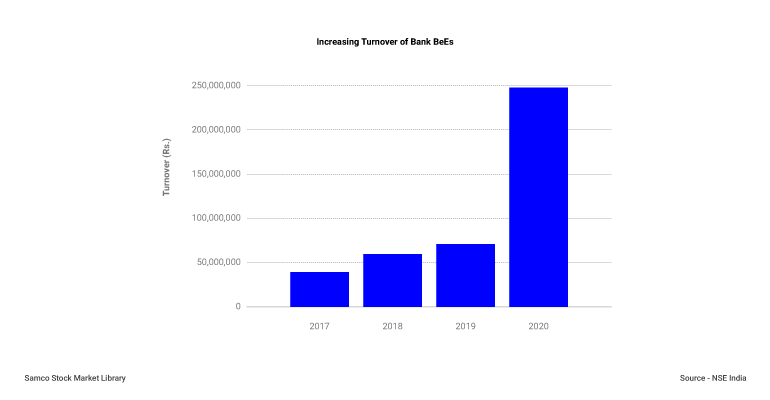
- No Pressure of Contract Expiry: Before Bank BeEs, you could only invest in Nifty Bank index via F&O. This required higher capital for margins. Contracts were compulsorily settled every month. Investors who were facing a loss were forced to close their positions. This led to lack of retail participation in Bank Nifty trading. But with Bank BeEs, investors do not have to worry about expiry or closing a position in loss. They can hold Bank BeEs units perpetually.
- No Exit Loads: Bank BeEs is a combination of shares and mutual funds. So, like a share it has no exit load. You can invest in Bank BeEs at 11 am and redeem at 11.30 am on the same day. There is absolutely no penalty by the fund house. This is unlike mutual funds where investors have to pay an exit load. For example:
- SBI Banking & Financial Services Fund charges an exit load of 0.5% for redemption within 30 days.
- Invesco India Financial Services Fund charges 1% for redemption within 365 days.
- Allows Intraday Trading: Intraday trading refers to quick short-term buying and selling of stocks. It is impossible in mutual funds as all investors are allotted the same closing NAV. But despite being a mutual fund, you can do intraday trading in Bank BeEs.
| Time | NAV | Units | Profit/Loss | Profit/Loss |
| 10.15 am | Rs. 349.59 | 285.0627 | 99,655 | 345 |
| 11.15 am | Rs. 349.60 | 285.0627 | 99,658 | 342 |
| 12.15 pm | Rs. 350.55 | 285.0627 | 99,929 | 71 |
| 1.15 pm | Rs. 350.47 | 285.0627 | 99,906 | 94 |
| 2.15 pm | Rs. 351.66 | 285.0627 | 1,00,245 | -245 |
| 3.15 pm | Rs. 352.64 | 285.0627 | 1,00,525 | -525 |
| 3.30 pm | Rs. 352.80 | 285.0627 | 1,00,570 | -570 |
- Least Tracking Error: Tracking error is the difference between the returns generated by your fund and its benchmark. Bank BeEs have the lowest tracking error. This directly benefits the investors as they earn near-exact returns as the benchmark index.
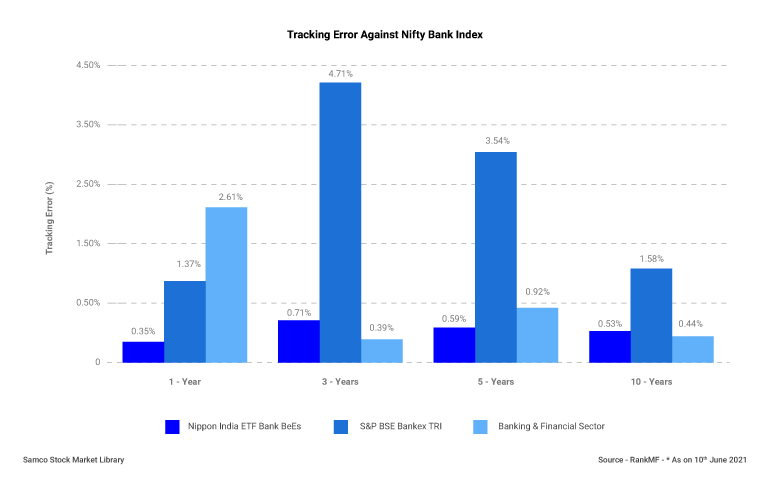
- No Fund Manager Bias: A fund manager is like the captain of a ship. He decides which stocks to invest in, when to book profits in a stock etc. Majority of the time, a fund benefits from his experience. But what if the fund manager holds a personal bias towards a stock?
Performance of Bank BeEs.
The value of Rs 1 Lakh invested in Bank BeEs would be worth the following: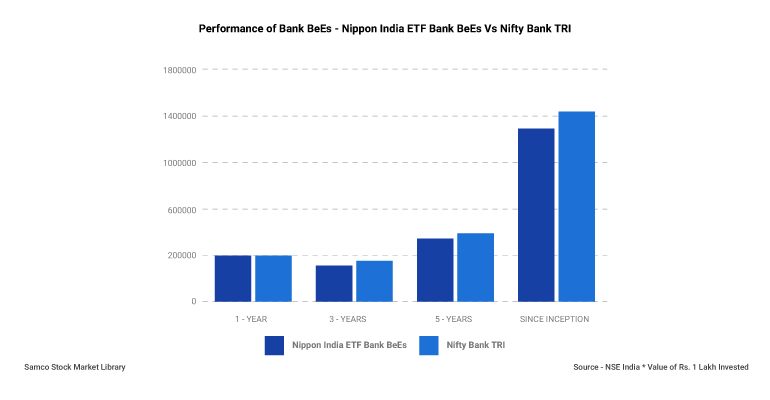
FAQs on Bank BeEs
- What is the difference between Bank BeEs and Nifty BeEs?
- What is the expense ratio of Bank BeEs?
- Are Bank BeEs safe?
| Dividend Date | Dividend (Rs/Unit) |
| 20-02-15 | 130 |
| 11-03-14 | 110 |
| 12-03-13 | 180 |
| 09-07-09 | 100 |
| 16-01-09 | 50 |
| 11-09-07 | 50 |
| 08-01-07 | 70 |
- Which are the Best Bank BeEs?
- How are Bank BeEs taxed?
- If you sell your units within 12 months, a flat short term capital gains tax of 15% is applicable.
- On selling units after 12 months, a long term capital gains tax of 10% is levied if gains exceed Rs 1 Lakh in a financial year.
- What is Nippon India ETF PSU Bank BeEs?



 Easy & quick
Easy & quick
Leave A Comment?